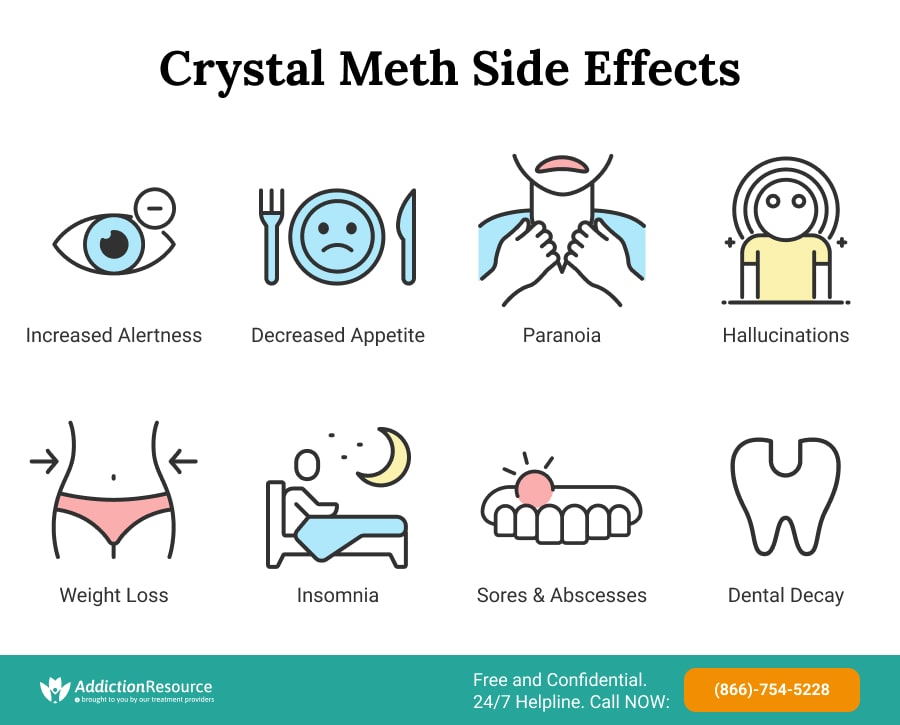Crystal meth side effects are harmful to all the major body organs, and some health damages are irreversible. Methamphetamine abuse wreaks the user’s physical and mental health, marks his appearance, impairs his ability to live a meaningful and productive life, and destroys relationships. Even babies born to mothers who abuse the drug are not spared; most of them carry the scars in their bodies and minds for years and well into adulthood. Although there are often reports of the U.S. Drug Enforcement Administration (DEA) seizing hundreds of kilograms of meth, the abuse of the drug continues.
Table Of Contents:
Instant Effects of Meth
Crystal meth is a potent central nervous system stimulant that can lead to addiction. It reaches the brain and signals it to produce large amounts of dopamine, the happy chemical. This produces a rush or a feeling of “high” that methamphetamine users crave.
Recreational use of methamphetamine is considered abuse and can be legally prosecuted.
The Short-Term Effects Of Meth Are:
- Euphoria or feelings of intense pleasure
- Increased alertness
- Increased physical activity
- Decreased fatigue
- Increased attention
- Decreased appetite
The flood of dopamine in the body triggers short-term effects like increased wakefulness and attention and decreased fatigue. Unfortunately, these are exactly the effects that make many people abuse methamphetamine as a performance-enhancing drug.
How Does Meth Affect the Brain?
Meth is neurotoxic. It is known to damage brain cells, sometimes irreversibly. Chronic drug abuse damages the brain structures and causes chemical changes. The effects are psychological, cognitive, motor, and behavioral.
Meth Side Effects On the Brain Are:
- Paranoia, hallucinations, and self-absorption
- Compulsive motor activities
- Aggressiveness and violence
- Decreased attention span
- Impaired thinking and judgment
- Reduced inhibition
- Memory impairment
- Increased risk of stroke
- Increased risk of Parkinson’s disease
- Chronic apathy
- Anhedonia
Some psychological, emotional, and behavioral effects of meth abuse hinder the user’s ability to function effectively as a responsible member of society, form and sustain healthy relationships, perform at the workplace, and hold on to jobs. Shabu, the variation of the drug in the Philippines, has shown even more serious side effects.
Crystal Meth Effects on the Body
Methamphetamine damages most other body organs like the heart, lungs, liver, and kidneys. Some meth-induced changes are irreversible and can trigger life-threatening complications.
Meth Side Effects On the Body Include:
- Drastic weight loss
- Insomnia and sleep deprivation
- Damage to the heart, lungs, liver, and kidneys
- Damage to the nasal pathways
- Infections, sores, and abscesses
- Dental decay
- Stress
- Malnutrition
- Aged appearance
Dangers Of Prolonged Use
Chronic methamphetamine abuse makes the user tolerant to the drug, so he progressively needs more of it to derive the same effect as before. Tolerance produces physical, emotional, and chemical dependence on the drug that eventually turns abuse into addiction and causes meth side effects to become more severe.
The Long-Term Physiological Methamphetamine Side Effects Are:
- Drastic weight loss
- Insomnia
- Damage to the heart, lungs, liver, and kidneys
- Damage to the nasal pathways, a common effect of snorting the drug
- Sores and abscesses that additionally increase the risk of infections
- Dental decay and “meth mouth“
- Sores on the body
- An aged appearance that is the result of poor diet and hygiene, the presence of various medical conditions, and a stressful lifestyle
The Long-Term Neurological, Psychological, And Behavioral Meth Side Effects Include:
- Psychotic symptoms similar to schizophrenia and marked by delusions, paranoia, visual and auditory hallucinations, and self-absorption
- Random, repetitive, and compulsive motor activities like twitching or scratching
- Aggressive or violent and sometimes homicidal behavior stemming from an inability to control impulses
- Decreased attention span
- Impaired thinking and judgment
- Reduced inhibition
- Memory impairment or loss
- Increased risk of stroke due to damage to blood vessels
- Increased risk of developing Parkinson’s disease due to reduced dopamine levels
- Chronic apathy
- Inability to experience pleasure (anhedonia) that may trigger suicidal thoughts
- The addictive disorder that manifests as compulsive drug-seeking behavior
- Structural and functional changes in the brain
Abstinence can improve motor and verbal learning abilities in most users. But sometimes, the psychotic effects of meth abuse tend to persist for months after quitting the drug.
Methamphetamine users who inject the drug are at a higher risk of contracting certain other diseases, such as hepatitis B and C, AIDS, bacterial infections, inflammation at the site of injection.
Effects Of Prolonged Meth Use On Body Organs
Meth can negatively affect health by causing serious and irreversible damage to organs, especially with long-term use. Moreover, as high tolerance to the drug may make users take higher doses leading to a methamphetamine overdose.
Some Of the Effects On the Heart Are:
- Cardiovascular System Damage: Methamphetamine stresses the heart by elevating blood pressure and disturbing its normal rhythmic patterns. These can lead to heart attacks.
- Development Of Clots: The drug constricts blood vessels and veins that can lead to the formation of clots.
- Rupture Of Arteries: Meth is toxic to large blood vessels. Continued use can tear arteries and cause fatal bleeding into the heart.
- Increased Risk Of Strokes: There is an increased risk of strokes from blood clots.
Methamphetamine damages the liver. Continued use increases the user’s risk of developing hepatitis that can progress to cirrhosis or his chances of succumbing to acute liver failure.
Drug dealers often lace meth with adulterants and bulking agents to increase their profits. Meth can contain toxins like battery acid, lead, drain cleaner, paint thinner, red phosphorus derived from matchsticks, lithium extracted from batteries, and Freon. Most of these elements are highly toxic and damage the kidneys and the lungs.
Meth Affects the Kidneys In the Following Ways:
- Elevated body temperature can cause the kidneys to shut down from dehydration.
- Consistently elevated blood pressure damages the kidneys and impairs their functionality.
- Consistently high body temperature and chronic muscle twitching can break down muscle tissue (rhabdomyolysis). This floods the body with toxins that are dangerous for the kidneys. The kidneys may even shut down.
- Methamphetamine can cause urine retention. The backflow of urine can cause kidney failure.
- It constricts blood vessels, and kidneys can shut down due to reduced blood flow.
Some of these damages brought on by methamphetamine are irreversible. Kidney failure can result in death if the person does not undergo dialysis promptly. In some cases, kidney transplantation is required. Else the person has to undergo dialysis for the rest of his life.
Methamphetamine Damages the Lungs In the Following Ways:
- The presence of toxins in crystal meth damages the lungs directly. The damage is greater in users who smoke the drug.
- Crystal meth vapors increase the number of free radicals in the lungs. This causes oxidative stress that damages the organ.
- Constricted blood vessels reduce the flow of blood to the lungs. This may cause fluid to accumulate in the lungs. This is a potentially life-threatening condition marked by breathlessness, chest pain, fatigue, and fainting.
Anhedonia Following Crystal Methamphetamine Use
Anhedonia is a very challenging side effect of meth use and can lead to other symptoms such as depression and suicidal thoughts. It is the inability to find pleasure from things that used to do just that. These can be usual little things like listening to music, or eating good food, to larger areas such as sexual activities or hobbies.
This is a state that can occur when methamphetamine has done permanent damage to an addict’s brain, to the point where he is neurologically incapable of deriving pleasure from activities he once did. This can be a major cause of relapse once an addict has detoxed from methamphetamine. While searching for feelings of pleasure, he discovers that he is no longer capable of finding it anywhere but in crystal methamphetamine. This is why addiction treatment programs are so helpful because they teach coping skills to manage those feelings.
Meth Use and Psychosis
Another frightening symptom that can occur is psychosis. In addition to symptoms of major depression, users may show signs of psychosis during the later stages of withdrawal.
Psychosis is not a disease. Rather it is a symptom. In most cases, it is a hallmark of schizophrenia. A study suggests meth-induced psychosis and schizophrenia may have a common genetic link.
Meth psychosis and other mental disorders have similar symptoms. For this reason, recognizing it is a challenge for clinicians. Health professionals should check substance abuse history before starting treatment.
This Is an Umbrella Term That in the Beginning Stages Includes:
- Feelings of suspicion
- General anxiety
- Distorted perceptions
- Depression
- Obsessive thinking
- Sleep problems
More Advanced Forms Of Psychosis Can Progress And Symptoms May Include:
- Hallucinations
- Delusions
- Disorganization (in behavior, thoughts, and speech)
- Disordered thinking (making unrelated correlations between thoughts)
- Catatonia (being unresponsive)
- Difficulty in concentration
Here what dr. Tarlow from Boca Recovery centers says on meth psychosis:
Meth Paranoia
One of the numerous crystal meth side effects is paranoia. The risk increases with long-term abuse. Meth paranoia is a severe condition. Thus, one should seek immediate medical care.
Paranoia is a distortion in the perception of one’s self and security. It causes them to think that everyone is conspiring against them. They exhibit hostile behavior and may harm others. Also, they have a false sense of self-importance. It is a symptom of an underlying mental disorder.
The link between methamphetamine and paranoia is well known. In the medical world, they call it meth-induced paranoia (MIP). But, only a few studies have attempted to differentiate MIP from paranoia due to other causes.
Many studies suggest an increased dopamine level may lead to the symptoms of schizophrenia, which is called the “dopamine hypothesis of schizophrenia.” In fact, many medications for schizophrenia reduce the brain dopamine level.
Long-term methamphetamine abuse may also cause some structural changes in the brain. Notably, the dopamine system is overactive in these patients.
The changes in brain chemistry and structure have a combined effect on how users think and behave. As a result, the typical symptoms of paranoia are developed. They include hallucinations and changes in thought processing. Additionally, they may fail to respond normally to external stimuli.
The Symptoms Of Meth Paranoia May Include:
- Listening to the voices that are not real
- Having irrational beliefs
- Unusual perception of sound, vision, or touch
Moreover, some patients may have olfactory hallucinations. It means they sense the smell that is not present in the environment. Some may have a false belief that someone is aware of their thoughts.
Other Symptoms May Include:
- Seeing things that do not exist
- A false belief that they do not have any mental health issues. As a result, they do not need any treatment
- Experiencing physical contact with an imaginary object or surface
If someone has meth paranoia, contact an addiction counselor. They can provide accurate information on a variety of addiction-related topics.
Effects of Meth in Pregnant Women
Methamphetamine harms both pregnant women and the fetus. Besides the above-mentioned short- and long-term effects, pregnant women who abuse the drug are also at an increased risk of the following:
- Bleeding
- Placenta breaking away from the wall of the uterus
- Miscarriage
- Premature delivery
- Babies born with physical defects and mental abnormalities
Effects Of Meth On the Developing Fetus and Children
According to a CBS News report, methamphetamine abuse during pregnancy or while breastfeeding affects the baby’s physical, psychological, and emotional development. The drug can cross the placental barrier and get absorbed by the blood and tissues of the developing fetus. It can also pass into the system of an infant through breast milk.
Meth Babies Tend to Exhibit the Following Behavioral Problems:
- Anxiety
- Depression
- Moodiness
- Aggressive behavior
- Attention problems similar to ADHD (Attention Deficit Hyperactivity Disorder)
Some of these behavioral problems last until adulthood and make it difficult for grown-up babies to behave appropriately in social settings and perform satisfactorily in academic environments.
Additionally, meth babies often display stunted growth, which is typically due to the poor diets and lack of personal hygiene of their mothers. According to findings from research studies, meth babies have higher rates of being born with brain and heart abnormalities and cleft palate than children born to non-meth using mothers.
Besides these effects, such babies are adversely affected by their mothers’ addictive disorders in several indirect ways, such as physical neglect and emotional indifference, the violence that the mother’s drug-seeking activities may attract, substance abuse disorders that they may develop as a way to cope with reality and mental disorders resulting from their stressful environments.
Getting Help For Crystal Meth Addiction
Meth can negatively affect health by causing serious and irreversible damage to organs. Methamphetamine abuse can also have severe mental health effects and can destroy mind, appearance, relationships, and ability to live a meaningful life.
If one suspects someone of abusing the drug, it is important to seek specialized medical help. Contact an addiction counselor. Their knowledge and experience in addiction treatment are invaluable to the journey to sobriety. In fact, with their guidance, a patient can expect a swift and complete recovery.
Addiction centers have every resource to help someone with an addiction. They have qualified medical professionals and individualized addiction treatment plans. Moreover, they also have provisions for auxiliary care.
Overcoming the addiction in time will prevent dangerous and sometimes irreversible side effects of the drug. Crystal meth addiction can be cured, and various rehabilitation centers and treatment programs can provide the necessary support for those who need it.
Page Sources
- Seyed Ramin Radfar and Richard A. Rawson. Current Research on Methamphetamine: Epidemiology, Medical and Psychiatric Effects, Treatment, and Harm Reduction Efforts. https://www.ncbi.nlm.nih.gov/pmc/articles/PMC4354220/
- Sandra M. Wells and Mary C. Buford. Acute Inhalation Exposure to Vaporized Methamphetamine Causes Lung Injury in Mice. http://www.ncbi.nlm.nih.gov/pmc/articles/PMC2753821/
- CBS News. Mom's meth use during pregnancy causes kids' behavioral problems. 2012. http://www.cbsnews.com/news/moms-meth-use-during-pregnancy-causes-kids-behavioral-problems/
- Tricia E. Wright, Renee Schuetter, Jacqueline Tellei, and Lynnae Sauvage.Methamphetamines and Pregnancy Outcomes. https://www.ncbi.nlm.nih.gov/pmc/articles/PMC4374990/
- Suzette Glasner-Edwards and Larissa J. Mooney. Methamphetamine Psychosis: Epidemiology and Management. https://www.ncbi.nlm.nih.gov/pmc/articles/PMC5027896/
- National Drug and Alcohol Research Centre, University of New South Wales. Methamphetamine Psychosis. 2006. https://ndarc.med.unsw.edu.au/sites/default/files/ndarc/resources/ICE%20PSYCHOSIS.pdf
- Health Direct. Ice and mental health. https://www.healthdirect.gov.au/ice-and-mental-health
- Martin H. Leamon, Keith Flower, Ruth E. Salo, Thomas E. Nordahl, Henry R. Kranzler, Gantt P. Galloway. Methamphetamine and Paranoia: The Methamphetamine Experience Questionnaire. The American Journal on Addictions. 2010 Mar-Apr; 19(2): 155–168. https://www.ncbi.nlm.nih.gov/pmc/articles/PMC3168774/
- Travis A. Wearne, Jennifer L. Cornish. A Comparison of Methamphetamine-Induced Psychosis and Schizophrenia: A Review of Positive, Negative, and Cognitive Symptomatology. Frontiers in Psychiatry. 2018. https://www.frontiersin.org/articles/10.3389/fpsyt.2018.00491/full
- Hart CL, Marvin CB, Silver R, Smith EE. Is cognitive functioning impaired in methamphetamine users? A critical review. Neuropsychopharmacology (2012) https://www.ncbi.nlm.nih.gov/pmc/articles/PMC3260986/









